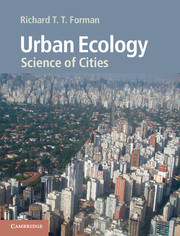Book contents
- Frontmatter
- Dedication
- Contents
- Foreword
- Preface
- Acknowledgments
- Part I Framework
- Part II Ecological features
- Part III Urban features
- 10 Human structures
- 11 Residential, commercial, industrial areas
- 12 Green spaces, corridors, systems
- Epilogue
- Appendix A Positive and negative attributes of an urban region
- Appendix B Equations
- References
- Index
11 - Residential, commercial, industrial areas
Published online by Cambridge University Press: 05 June 2014
- Frontmatter
- Dedication
- Contents
- Foreword
- Preface
- Acknowledgments
- Part I Framework
- Part II Ecological features
- Part III Urban features
- 10 Human structures
- 11 Residential, commercial, industrial areas
- 12 Green spaces, corridors, systems
- Epilogue
- Appendix A Positive and negative attributes of an urban region
- Appendix B Equations
- References
- Index
Summary
A city that outdistances man’s walking powers is a trap.
Arnold Toynbee, quoted in The American Land, 1979… features which permit a rich flora and fauna to survive—the squalor, rubbish, old buildings and machinery, derelict huts, rotting dumps, inefficient handling … Bags burst, containers leak, … approved methods of waste disposal are not always followed and the result is a persistent scatter of alien plants …
Oliver L. Gilbert, The Ecology of Urban Habitats, 1991In describing your city to a friend on a distant continent, you send stunning photos of a favorite park, a museum, a historic site, the sports stadium, and the skyscraper area. She warmly thanks you for glimpses of these spots, but wonders if you could explain what your metro area is really like. Surprised but intrigued, you quickly get your camera and make a list of places to photograph. Where do we live, work, and shop?
For residential areas, maybe single-family house plots, low-rise apartments/condominiums, high rises, courtyard/patio housing, and even informal squatter settlement are to be photographed. For commercial areas, take photos of the city-center business district, an office center, town center, strip/ribbon development, shopping mall, warehouse trucking center, and certainly neighborhood streets with small shops. For industrial areas, photos of both active manufacturing sites and post-industrial brownfields are important.
- Type
- Chapter
- Information
- Urban EcologyScience of Cities, pp. 314 - 342Publisher: Cambridge University PressPrint publication year: 2014

